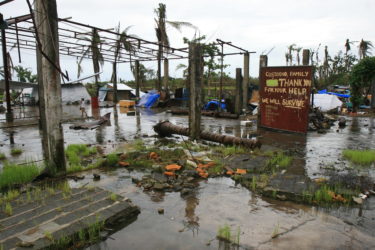
16.1 Million People Displaced By Weather Disasters, More Than By Conflict
In 2018, 16.1 million people fled their homes as a result of a weather-related disasters. Climate change is worsening storms and contributing to the displacement of millions of people. When large populations pick-up their lives and move there is a potential for instability. The US has an opportunity to help make countries more resilient in the face of climate change, while also saving money and strengthening its national security and diplomatic standing.
The Internal Displacement Monitoring Centre (IDMC) issued its annual report in May 2019. According to the report, 28 million people were newly displaced because of conflict and disaster.
News reports tend to focus on those displaced due to conflict. Interestingly, however, the number of people displaced due to weather-related disasters was larger than those displaced by conflict. Conflict displaced roughly 10.8 million people, but 16.1 million people were displaced as the result of weather-related events.
According to the report, displacement associated with disasters mainly affected East Asia and the Pacific and South Asia regions.
In East Asia and the Pacific, 9.3 million displacements were triggered by disasters. That accounts for more than half of all new weather disaster displacements. In the Philippines, 3.8 million people were displaced; 1.6 million people displaced as a result of Typhoon Mangkhut alone. Additionally, nearly 3.8 million people were displaced in China because of typhoons.
The South Asia region recorded 3.3 million disaster-related displacements. Kerala, India recorded “the worst floods in a century,” triggering the displacement of 1.5 million people. Cyclones in India displaced an additional 650,000 people.
Combined, the displaced people in the Philippines, China, and India make up roughly 60 percent of all new disaster displacements.
Where are these people going?
According to the IDMC report, most of those displaced by disaster are moving to, and within, urban areas. When large numbers of people seek refuge in cities, the whole urban system is affected. Competition for work increases, as does the demand for transportation, healthcare, education, and other services. If institutions are weak, the increased demand for services will likely weaken them further.
Climate change is increasing the frequency and intensity of weather-related hazards, which will make competition among urban dwellers more acute. Badly managed rapid urbanization will stretch the capacity of governments to deal with displacement, potentially triggering instability. Preparing urban areas for the effects of climate change and bolstering institutions to deal with an increase in displacements is crucial to minimizing the possibility of instability.
What should the US do?
It is in the US’ national interest to help climate vulnerable countries mitigate and adapt to potential weather-related disasters and build resilient government institutions that can handle rapid urbanization. Investing in measures to make countries more resilient is smart policy for the US for three reasons: (1) it saves US taxpayer dollars in the long-run, (2) it strengthens America’s national security, and (3) it bolsters the US’ diplomatic standing in the region.
First, when the US invests in making countries, more resilient, it saves taxpayer dollars. When disaster strikes, the US sends millions in humanitarian assistance, aid, and logistics support to facilitate disaster clean-up. When Typhoon Haiyan descended on the Philippines, the US sent the USS George Washington and its escort ships, the USNS Mercy, $20 million in humanitarian aid, and 90 US Marines to assist with relief efforts. Investing in mitigation and adaptation programs will likely cost less than mobilizing a carrier group, humanitarian aid, and other resources needed to clean-up after a disaster.
Second, developing resilient government institutions that can handle the pressures of rapid urbanization strengthens US national security. Weak institutions and instability create space for nefarious activities, such as transnational crime and terrorism. If government institutions weaken under the pressures of disasters and rapid urbanization, terrorist groups, such as Abu Sayyaf in the Philippines, may seek to exploit this weakness. Such a development would pose a threat to US security interests in the region.
Finally, many of the world’s most climate vulnerable countries are in Southeast Asia and China’s backyard. As a rising power, China is trying to expand its sphere of influence through “climate aid” or “climate diplomacy.” To counter China, the US should provide financial and technical assistance for mitigation, adaptation, and building strong government institutions, more closely tying countries to the US.
Storms are predicted to worsen, but there is an opportunity for the US to mitigate the threats posed by climate change. Helping to make countries more resilient—to climate change and the effects of rapid urbanization—saves US taxpayer dollars, protects national security interests, and strengthens diplomatic standing. Ultimately, however, these measures are just Band-Aids unless the US demonstrates global leadership by cutting greenhouse gas emissions.





